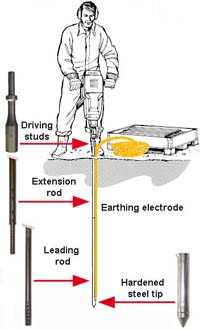Deep earthing without conductor joints
An earth electrode is a conductor placed in the soil, with the purpose of discharging electric current from a connected facility.
 |
Principle An earthing electrode consisting of a copper wire that is driven down by a system consisting of an 0.8 metre long steel leading rod with a hardened steel tip at the end, and extension rods, that pave the way for the earthing electrode to be buried in the soil. The earthing resistance is continuously measured at one end of the electrode wire, and when a suitable value is obtained, the driving process is stopped and the last extension rod is pulled out. Driving is done with the aid of a power hammer with a suitably adapted driving stud or with a sledgehammer and driving cap. Advantages • no jointing of the earthing electrode or earthing wire • large cross-sectional area: 16-95 mm² • can be used for different types of wire • corrosion-resistant – very long life • control to prevent the wire and tip striking against rock • possibility to continually measure the grounding resistance • few parts, making driving uncomplicated and operationally reliable • low cost and weight compared to other systems |